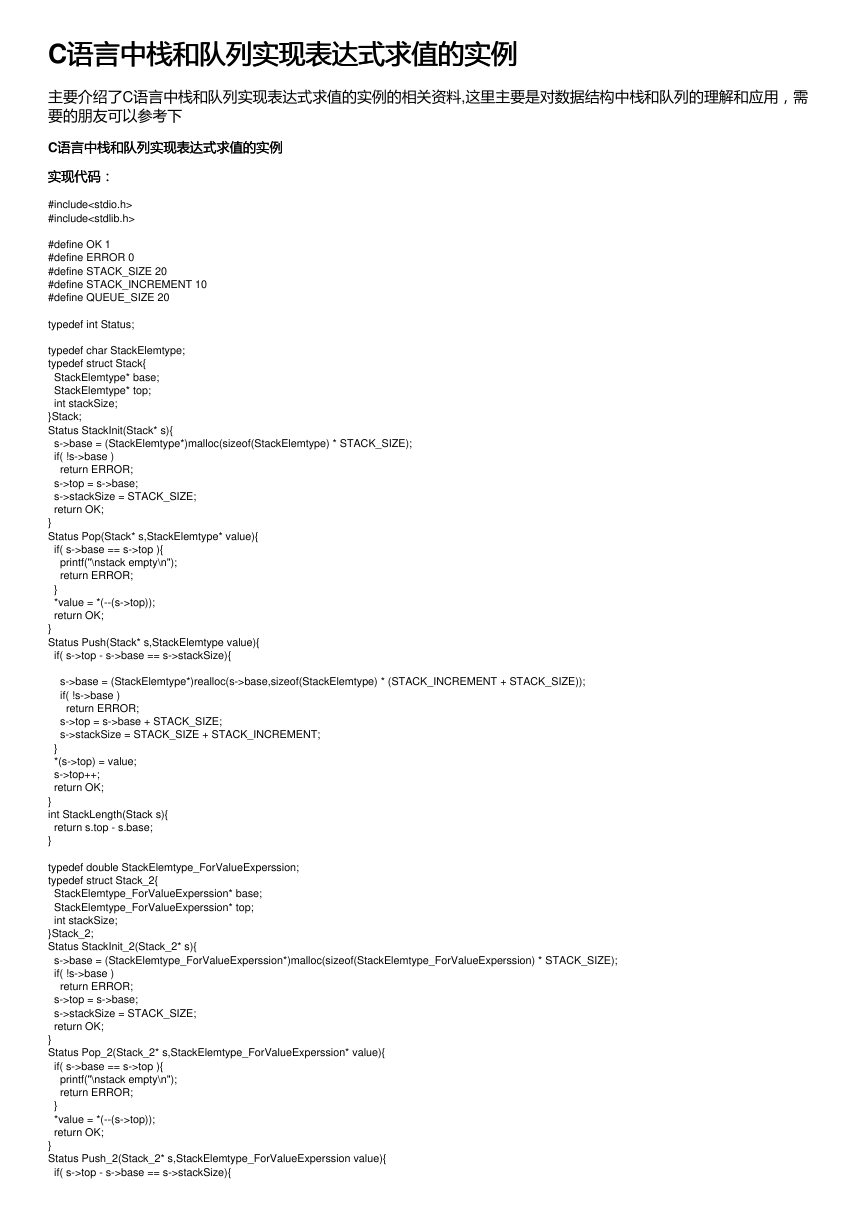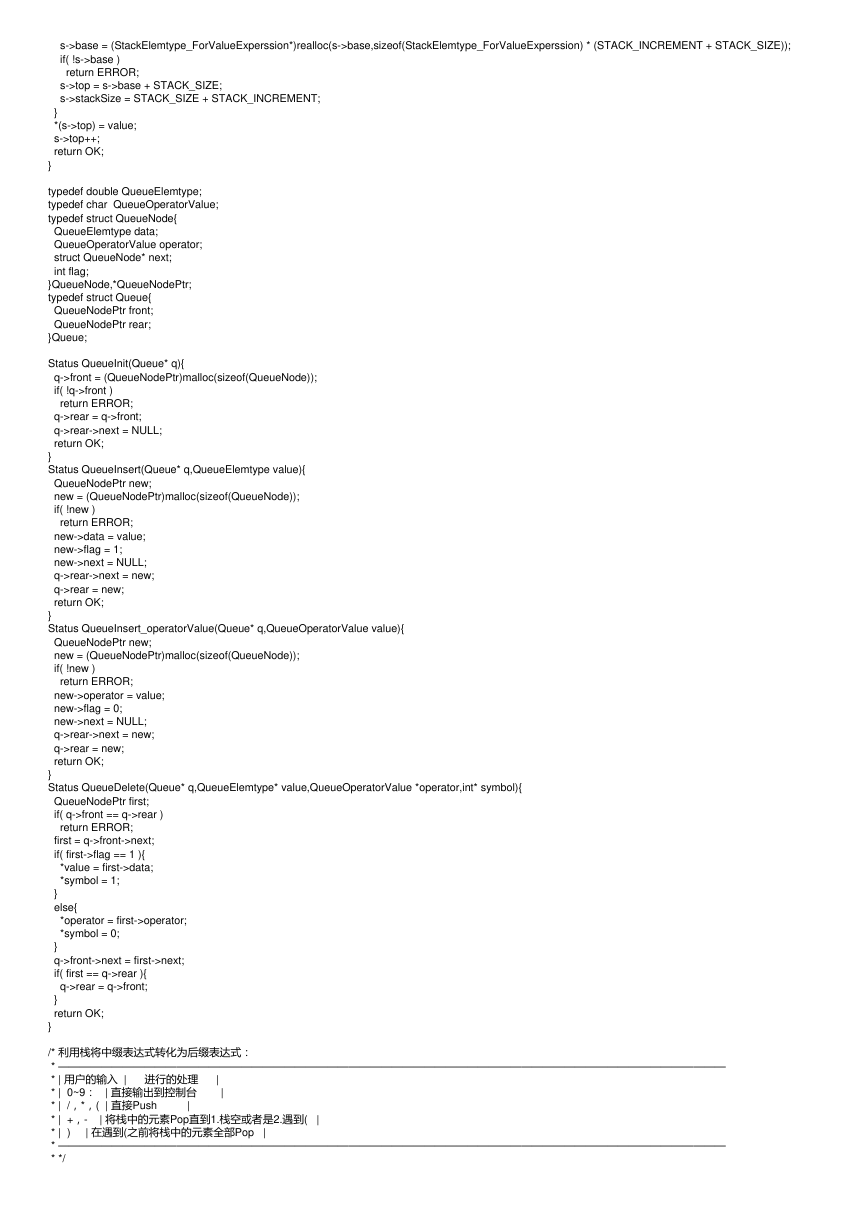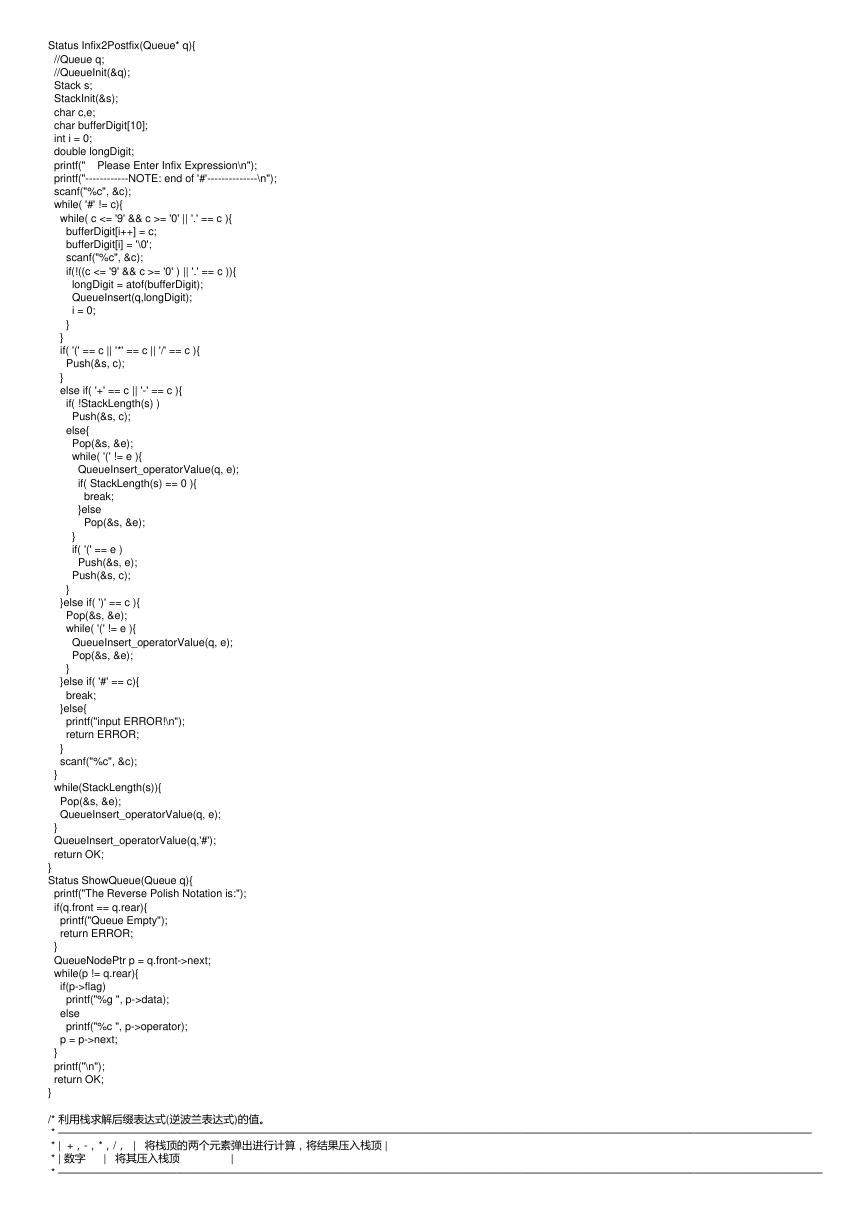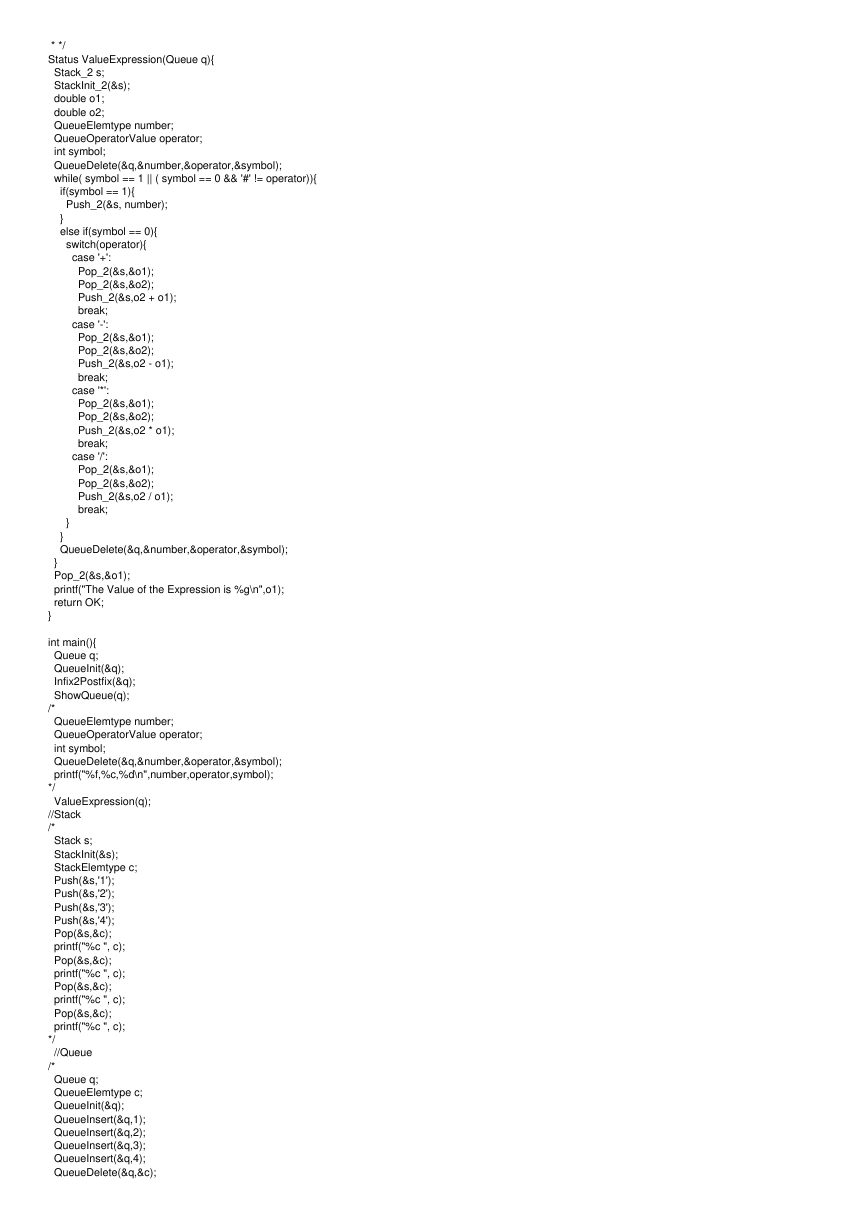C语言中栈和队列实现表达式求值的实例
语言中栈和队列实现表达式求值的实例
主要介绍了C语言中栈和队列实现表达式求值的实例的相关资料,这里主要是对数据结构中栈和队列的理解和应用,需
要的朋友可以参考下
C语言中栈和队列实现表达式求值的实例
语言中栈和队列实现表达式求值的实例
实现代码:
实现代码:
#include
#include
#define OK 1
#define ERROR 0
#define STACK_SIZE 20
#define STACK_INCREMENT 10
#define QUEUE_SIZE 20
typedef int Status;
typedef char StackElemtype;
typedef struct Stack{
StackElemtype* base;
StackElemtype* top;
int stackSize;
}Stack;
Status StackInit(Stack* s){
s->base = (StackElemtype*)malloc(sizeof(StackElemtype) * STACK_SIZE);
if( !s->base )
return ERROR;
s->top = s->base;
s->stackSize = STACK_SIZE;
return OK;
}
Status Pop(Stack* s,StackElemtype* value){
if( s->base == s->top ){
printf("\nstack empty\n");
return ERROR;
}
*value = *(--(s->top));
return OK;
}
Status Push(Stack* s,StackElemtype value){
if( s->top - s->base == s->stackSize){
s->base = (StackElemtype*)realloc(s->base,sizeof(StackElemtype) * (STACK_INCREMENT + STACK_SIZE));
if( !s->base )
return ERROR;
s->top = s->base + STACK_SIZE;
s->stackSize = STACK_SIZE + STACK_INCREMENT;
}
*(s->top) = value;
s->top++;
return OK;
}
int StackLength(Stack s){
return s.top - s.base;
}
typedef double StackElemtype_ForValueExperssion;
typedef struct Stack_2{
StackElemtype_ForValueExperssion* base;
StackElemtype_ForValueExperssion* top;
int stackSize;
}Stack_2;
Status StackInit_2(Stack_2* s){
s->base = (StackElemtype_ForValueExperssion*)malloc(sizeof(StackElemtype_ForValueExperssion) * STACK_SIZE);
if( !s->base )
return ERROR;
s->top = s->base;
s->stackSize = STACK_SIZE;
return OK;
}
Status Pop_2(Stack_2* s,StackElemtype_ForValueExperssion* value){
if( s->base == s->top ){
printf("\nstack empty\n");
return ERROR;
}
*value = *(--(s->top));
return OK;
}
Status Push_2(Stack_2* s,StackElemtype_ForValueExperssion value){
if( s->top - s->base == s->stackSize){
�
s->base = (StackElemtype_ForValueExperssion*)realloc(s->base,sizeof(StackElemtype_ForValueExperssion) * (STACK_INCREMENT + STACK_SIZE));
if( !s->base )
return ERROR;
s->top = s->base + STACK_SIZE;
s->stackSize = STACK_SIZE + STACK_INCREMENT;
}
*(s->top) = value;
s->top++;
return OK;
}
typedef double QueueElemtype;
typedef char QueueOperatorValue;
typedef struct QueueNode{
QueueElemtype data;
QueueOperatorValue operator;
struct QueueNode* next;
int flag;
}QueueNode,*QueueNodePtr;
typedef struct Queue{
QueueNodePtr front;
QueueNodePtr rear;
}Queue;
Status QueueInit(Queue* q){
q->front = (QueueNodePtr)malloc(sizeof(QueueNode));
if( !q->front )
return ERROR;
q->rear = q->front;
q->rear->next = NULL;
return OK;
}
Status QueueInsert(Queue* q,QueueElemtype value){
QueueNodePtr new;
new = (QueueNodePtr)malloc(sizeof(QueueNode));
if( !new )
return ERROR;
new->data = value;
new->flag = 1;
new->next = NULL;
q->rear->next = new;
q->rear = new;
return OK;
}
Status QueueInsert_operatorValue(Queue* q,QueueOperatorValue value){
QueueNodePtr new;
new = (QueueNodePtr)malloc(sizeof(QueueNode));
if( !new )
return ERROR;
new->operator = value;
new->flag = 0;
new->next = NULL;
q->rear->next = new;
q->rear = new;
return OK;
}
Status QueueDelete(Queue* q,QueueElemtype* value,QueueOperatorValue *operator,int* symbol){
QueueNodePtr first;
if( q->front == q->rear )
return ERROR;
first = q->front->next;
if( first->flag == 1 ){
*value = first->data;
*symbol = 1;
}
else{
*operator = first->operator;
*symbol = 0;
}
q->front->next = first->next;
if( first == q->rear ){
q->rear = q->front;
}
return OK;
}
/* 利用栈将中缀表达式转化为后缀表达式:
* ——————————————————————————————————————————————————————————————
* | 用户的输入 | 进行的处理 |
* | 0~9: | 直接输出到控制台 |
* | /,*,( | 直接Push |
* | +,- | 将栈中的元素Pop直到1.栈空或者是2.遇到( |
* | ) | 在遇到(之前将栈中的元素全部Pop |
* ——————————————————————————————————————————————————————————————
* */
�
Status Infix2Postfix(Queue* q){
//Queue q;
//QueueInit(&q);
Stack s;
StackInit(&s);
char c,e;
char bufferDigit[10];
int i = 0;
double longDigit;
printf(" Please Enter Infix Expression\n");
printf("------------NOTE: end of '#'--------------\n");
scanf("%c", &c);
while( '#' != c){
while( c <= '9' && c >= '0' || '.' == c ){
bufferDigit[i++] = c;
bufferDigit[i] = '\0';
scanf("%c", &c);
if(!((c <= '9' && c >= '0' ) || '.' == c )){
longDigit = atof(bufferDigit);
QueueInsert(q,longDigit);
i = 0;
}
}
if( '(' == c || '*' == c || '/' == c ){
Push(&s, c);
}
else if( '+' == c || '-' == c ){
if( !StackLength(s) )
Push(&s, c);
else{
Pop(&s, &e);
while( '(' != e ){
QueueInsert_operatorValue(q, e);
if( StackLength(s) == 0 ){
break;
}else
Pop(&s, &e);
}
if( '(' == e )
Push(&s, e);
Push(&s, c);
}
}else if( ')' == c ){
Pop(&s, &e);
while( '(' != e ){
QueueInsert_operatorValue(q, e);
Pop(&s, &e);
}
}else if( '#' == c){
break;
}else{
printf("input ERROR!\n");
return ERROR;
}
scanf("%c", &c);
}
while(StackLength(s)){
Pop(&s, &e);
QueueInsert_operatorValue(q, e);
}
QueueInsert_operatorValue(q,'#');
return OK;
}
Status ShowQueue(Queue q){
printf("The Reverse Polish Notation is:");
if(q.front == q.rear){
printf("Queue Empty");
return ERROR;
}
QueueNodePtr p = q.front->next;
while(p != q.rear){
if(p->flag)
printf("%g ", p->data);
else
printf("%c ", p->operator);
p = p->next;
}
printf("\n");
return OK;
}
/* 利用栈求解后缀表达式(逆波兰表达式)的值。
* ——————————————————————————————————————————————————————————————————————
* | +,-,*,/, | 将栈顶的两个元素弹出进行计算,将结果压入栈顶 |
* | 数字 | 将其压入栈顶 |
* ———————————————————————————————————————————————————————————————————————
�
* */
Status ValueExpression(Queue q){
Stack_2 s;
StackInit_2(&s);
double o1;
double o2;
QueueElemtype number;
QueueOperatorValue operator;
int symbol;
QueueDelete(&q,&number,&operator,&symbol);
while( symbol == 1 || ( symbol == 0 && '#' != operator)){
if(symbol == 1){
Push_2(&s, number);
}
else if(symbol == 0){
switch(operator){
case '+':
Pop_2(&s,&o1);
Pop_2(&s,&o2);
Push_2(&s,o2 + o1);
break;
case '-':
Pop_2(&s,&o1);
Pop_2(&s,&o2);
Push_2(&s,o2 - o1);
break;
case '*':
Pop_2(&s,&o1);
Pop_2(&s,&o2);
Push_2(&s,o2 * o1);
break;
case '/':
Pop_2(&s,&o1);
Pop_2(&s,&o2);
Push_2(&s,o2 / o1);
break;
}
}
QueueDelete(&q,&number,&operator,&symbol);
}
Pop_2(&s,&o1);
printf("The Value of the Expression is %g\n",o1);
return OK;
}
int main(){
Queue q;
QueueInit(&q);
Infix2Postfix(&q);
ShowQueue(q);
/*
QueueElemtype number;
QueueOperatorValue operator;
int symbol;
QueueDelete(&q,&number,&operator,&symbol);
printf("%f,%c,%d\n",number,operator,symbol);
*/
ValueExpression(q);
//Stack
/*
Stack s;
StackInit(&s);
StackElemtype c;
Push(&s,'1');
Push(&s,'2');
Push(&s,'3');
Push(&s,'4');
Pop(&s,&c);
printf("%c ", c);
Pop(&s,&c);
printf("%c ", c);
Pop(&s,&c);
printf("%c ", c);
Pop(&s,&c);
printf("%c ", c);
*/
//Queue
/*
Queue q;
QueueElemtype c;
QueueInit(&q);
QueueInsert(&q,1);
QueueInsert(&q,2);
QueueInsert(&q,3);
QueueInsert(&q,4);
QueueDelete(&q,&c);
�
printf("%d ", c);
QueueDelete(&q,&c);
printf("%d ", c);
QueueDelete(&q,&c);
printf("%d ", c);
QueueDelete(&q,&c);
printf("%d ", c);
if(QueueDelete(&q,&c)){
printf("%d ",c);
}
*/
/*
Queue q;
QueueInit(&q);
QueueInsert(&q,2.1);
QueueInsert_operatorValue(&q,'+');
QueueInsert(&q,43.1);
QueueInsert_operatorValue(&q,'a');
QueueInsert_operatorValue(&q,'(');
int iswho;
double d;
char c;
QueueDelete(&q,&d,&c,&iswho);
if(iswho == 1)
printf("%f ",d);
else
printf("%c ", c);
QueueDelete(&q,&d,&c,&iswho);
if(iswho == 1)
printf("%f ",d);
else
printf("%c ", c);
QueueDelete(&q,&d,&c,&iswho);
if(iswho == 1)
printf("%f ",d);
else
printf("%c ", c);
QueueDelete(&q,&d,&c,&iswho);
if(iswho == 1)
printf("%f ",d);
else
printf("%c ", c);
*/
return 0;
}
以上就是C语言数据结构中栈和队列的应用,如有疑问请留言或者到本站社区交流讨论,感谢阅读,希望能帮助到大家,谢谢大家对
本站的支持!
�










 2023年江西萍乡中考道德与法治真题及答案.doc
2023年江西萍乡中考道德与法治真题及答案.doc 2012年重庆南川中考生物真题及答案.doc
2012年重庆南川中考生物真题及答案.doc 2013年江西师范大学地理学综合及文艺理论基础考研真题.doc
2013年江西师范大学地理学综合及文艺理论基础考研真题.doc 2020年四川甘孜小升初语文真题及答案I卷.doc
2020年四川甘孜小升初语文真题及答案I卷.doc 2020年注册岩土工程师专业基础考试真题及答案.doc
2020年注册岩土工程师专业基础考试真题及答案.doc 2023-2024学年福建省厦门市九年级上学期数学月考试题及答案.doc
2023-2024学年福建省厦门市九年级上学期数学月考试题及答案.doc 2021-2022学年辽宁省沈阳市大东区九年级上学期语文期末试题及答案.doc
2021-2022学年辽宁省沈阳市大东区九年级上学期语文期末试题及答案.doc 2022-2023学年北京东城区初三第一学期物理期末试卷及答案.doc
2022-2023学年北京东城区初三第一学期物理期末试卷及答案.doc 2018上半年江西教师资格初中地理学科知识与教学能力真题及答案.doc
2018上半年江西教师资格初中地理学科知识与教学能力真题及答案.doc 2012年河北国家公务员申论考试真题及答案-省级.doc
2012年河北国家公务员申论考试真题及答案-省级.doc 2020-2021学年江苏省扬州市江都区邵樊片九年级上学期数学第一次质量检测试题及答案.doc
2020-2021学年江苏省扬州市江都区邵樊片九年级上学期数学第一次质量检测试题及答案.doc 2022下半年黑龙江教师资格证中学综合素质真题及答案.doc
2022下半年黑龙江教师资格证中学综合素质真题及答案.doc